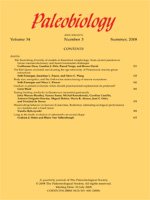Accurate estimates of predation intensity, the frequency of mortality from predation, are critical to studies of the evolution of species in response to predation, and to studies of predator-prey systems in general. Most commonly used indirect proxies for predation intensity in the fossil record have logistical or theoretical problems. Direct proxies, using actual traces of predatory activity, such as drilling and repair scars, may hold more promise. However, these direct proxies often have been used in conjunction with optimal foraging models, and in this context, the underlying assumptions and predictions of optimal foraging are examined.
Results from theoretical models using optimal foraging suggest that (1) the ratio of internal shell volume to shell thickness of prey (benefit/cost ratio) may be a questionable measurement of prey “value” to the predator, as it fails to account adequately for energetic cost to the predator during pursuit and grappling; (2) drilling and repair frequency are invalid measures of prey preference, because optimal foraging predicts that specific prey types are either always taken or always ignored; (3) pooled drilling frequency will not be a useful metric of predation intensity in systems in which the predator need not always drill; and (4) an increase in repair frequency can be a consequence of either an increase or a decrease in predation intensity.
Although drilling frequency may not indicate prey preference, it is a valid proxy for selection due to predation. An approach using size classes, in which the minimum size at which a predation refuge is achieved, is suggested for use with repair frequency.





